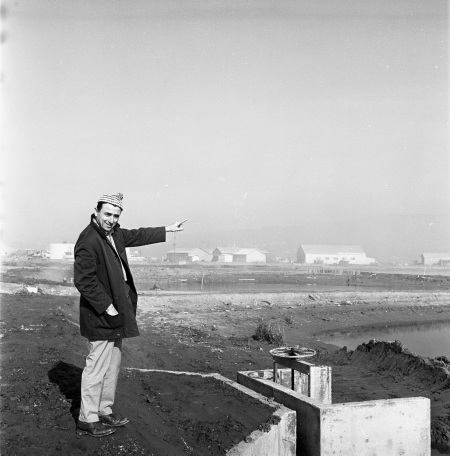Early Wastewater Treatment

Figure 4: George Allen at marsh/water treatment facility, 1972 [4].
In 1933 a single pipe that went to the Bay with raw sewage from Arcata. This 400-foot pipe emptied into a 500-foot ditch east of Butcher’s Mouth Slough. The development of Arcata’s wastewater treatment plan did not begin until 1949. At this time, only primary treatment was done to Arcata’s wastewater before it was discharged into the Bay.
In 1957, 55 acres of oxidation ponds were added to put wastewater through a secondary treatment process. In 1966 chlorination was added to treatment process. In 1975 the Humboldt Bay Wastewater Authority proposed a regional wastewater treatment plant, prompted by the Clean Water Act (1972). This act required enhancement of the receiving waters if treated effluent was released into the Bay [4,7].
In response to this policy the local Humboldt Bay Wastewater Authority proposed the construction of a regional wastewater treatment plant that would serve the communities of Humboldt Bay. This plan involved building a sewage line that would run from McKinleyville to Eureka. The proposed facility was energy intensive and required a lot of infrastructure that would be built around the Bay as well as a line that would cross under the Bay in an area where there was high vessel traffic. Due to the recognized constraints of the environment as well as criteria for wastewater treatment, the residents of Arcata appealed the proposal [4,6,7]. The City of Arcata explored alternative options [7].
In 1957, 55 acres of oxidation ponds were added to put wastewater through a secondary treatment process. In 1966 chlorination was added to treatment process. In 1975 the Humboldt Bay Wastewater Authority proposed a regional wastewater treatment plant, prompted by the Clean Water Act (1972). This act required enhancement of the receiving waters if treated effluent was released into the Bay [4,7].
In response to this policy the local Humboldt Bay Wastewater Authority proposed the construction of a regional wastewater treatment plant that would serve the communities of Humboldt Bay. This plan involved building a sewage line that would run from McKinleyville to Eureka. The proposed facility was energy intensive and required a lot of infrastructure that would be built around the Bay as well as a line that would cross under the Bay in an area where there was high vessel traffic. Due to the recognized constraints of the environment as well as criteria for wastewater treatment, the residents of Arcata appealed the proposal [4,6,7]. The City of Arcata explored alternative options [7].
